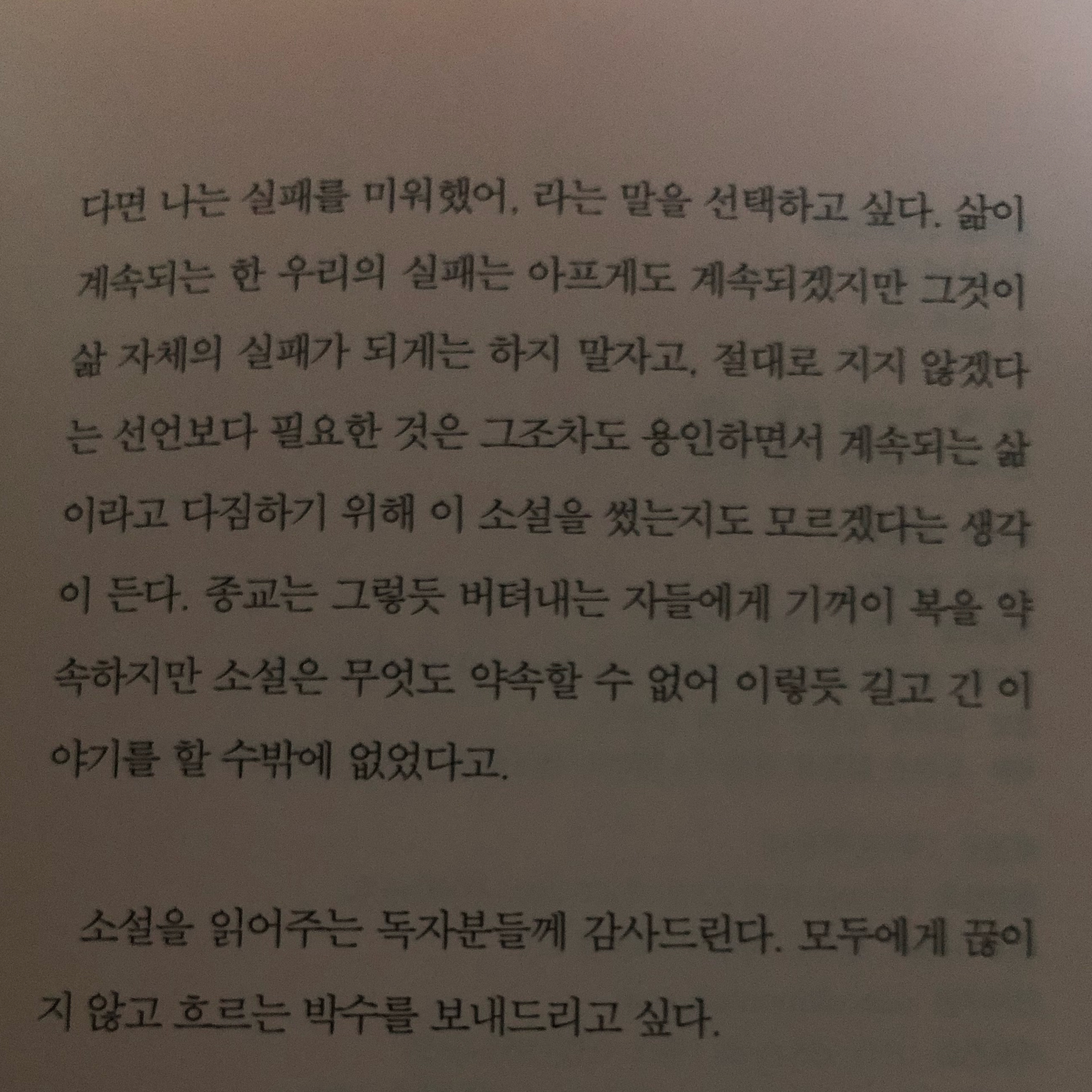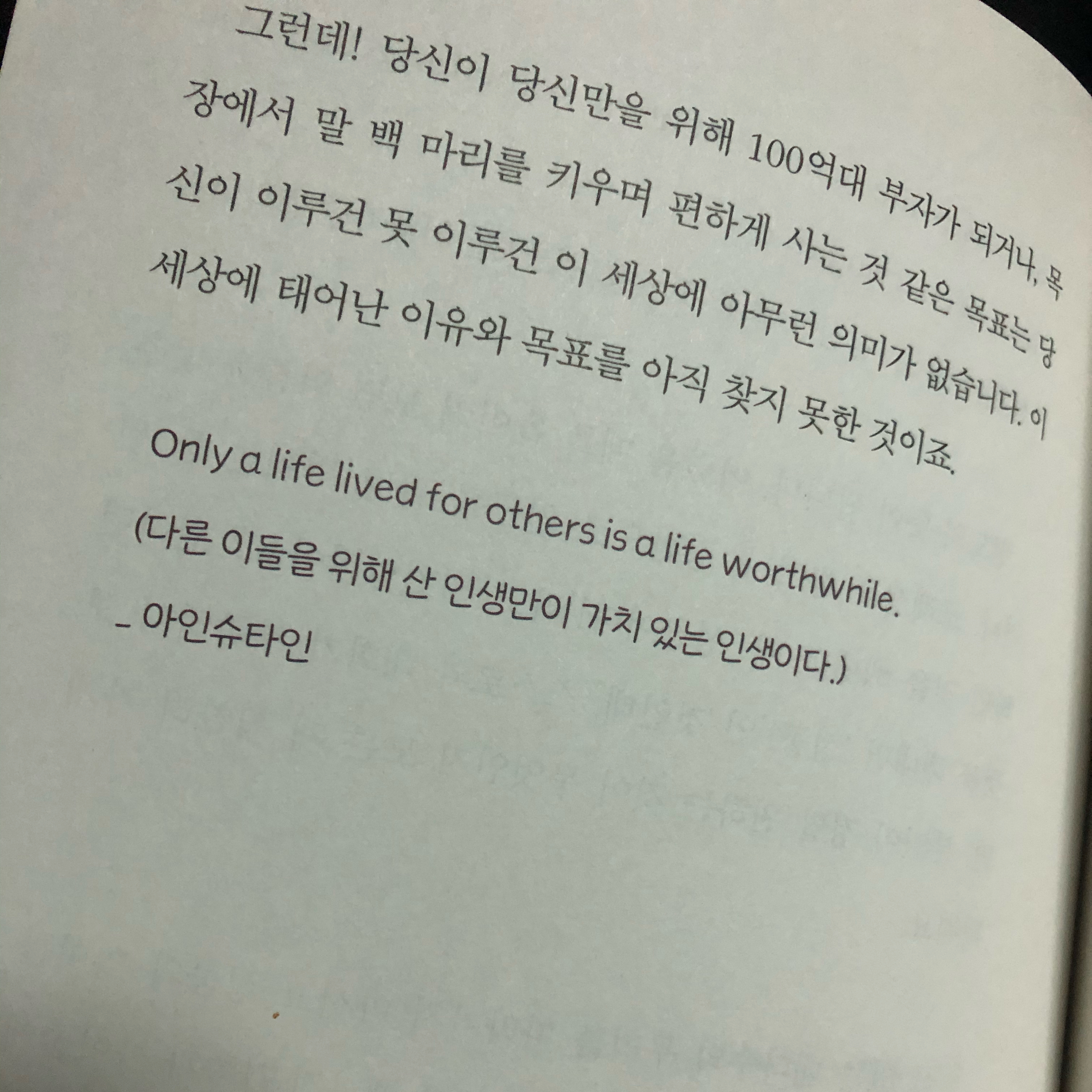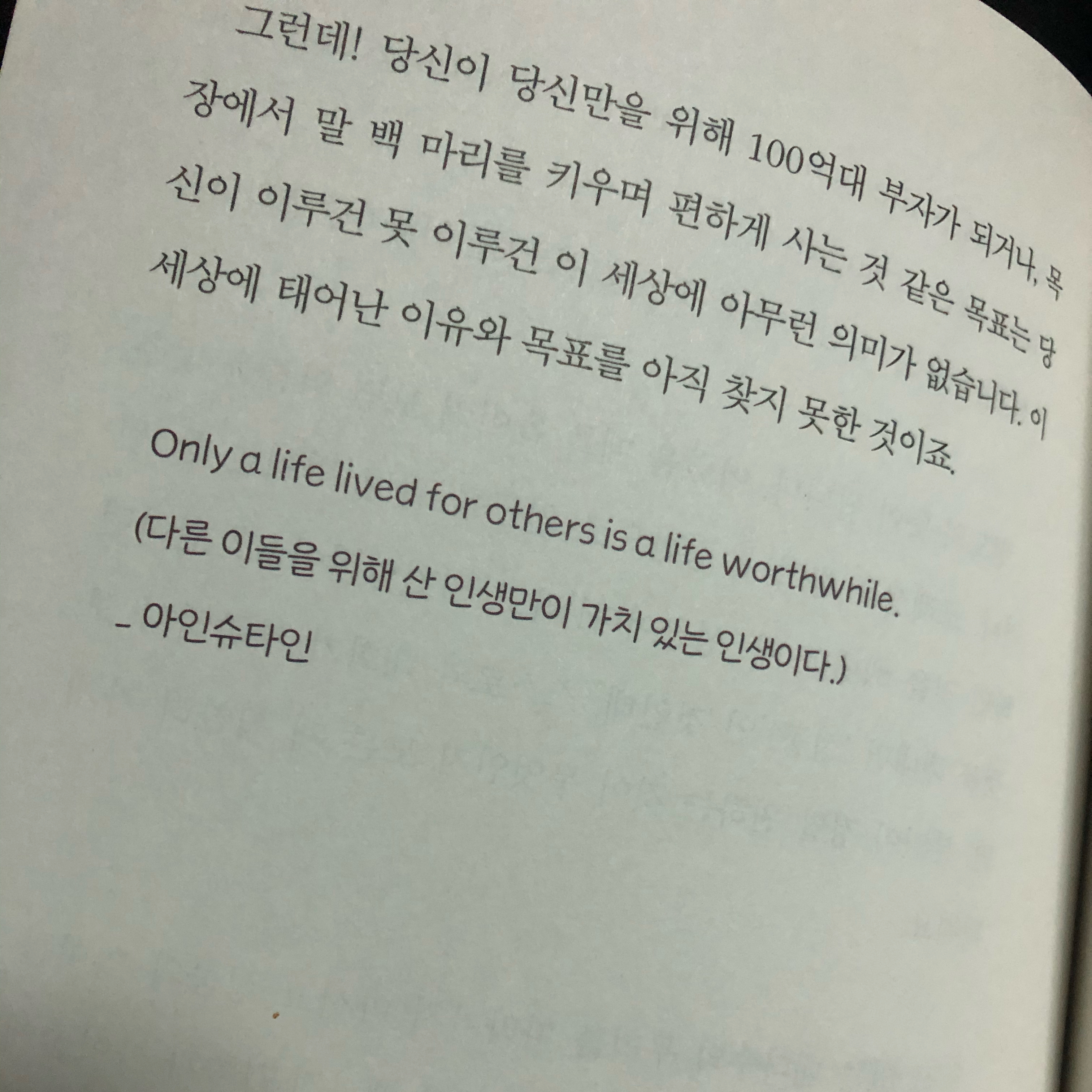
정아름
@jungareumhynq
+ 팔로우


이 글에서 가장 인상 깊었던 말은 '작가의 말'이다.
'소설의 한 문장을 고르라고 한다면 나는 실패를 미워했어. 라는 말을 선택하고 싶다. 삶이 계속되는 한 우리의 실패는 아프게도 계속되겠지만 그것이 삶 자체의 실패가 되게는 하지 말자고, 절대로 지지 않겠다는 선언보다 필요한 것은 그조차도 용인하면서 계속되는 삶이라고 다짐하기 위해 이 소설을 썼는지도 모르겠다는 생각이 든다. 종교는 그렇듯 버텨내는 자들에게 기꺼이 복을 약속하지만 소설은 무엇도 약속할 수 없어 이렇듯 길고 긴 이야기를 살 수 밖에 없다고.'
나에게 필요한 말이 아닌가싶다. 나 또한 실패를 미워했고, 실패하지 않기 위해 부단하게 살아왔기때문이다.
그 덕에 몸과 마음은 늘 지쳐있었고 힘이 들었다.
나를 옥죄는 것에 끝까지 도달한 후 조금씩 나를 내려놨고, 그러던 중 이 책을 만났다. 절대로 지지 않겠다는 선언보다 용인하면서 살아가는 삶...
쉽진 않지만 내가 살아남기 위해, 내 마음을 보호하기 위해, 나에게도 너에게도 필요한 말이 아닌가 싶다.
'소설의 한 문장을 고르라고 한다면 나는 실패를 미워했어. 라는 말을 선택하고 싶다. 삶이 계속되는 한 우리의 실패는 아프게도 계속되겠지만 그것이 삶 자체의 실패가 되게는 하지 말자고, 절대로 지지 않겠다는 선언보다 필요한 것은 그조차도 용인하면서 계속되는 삶이라고 다짐하기 위해 이 소설을 썼는지도 모르겠다는 생각이 든다. 종교는 그렇듯 버텨내는 자들에게 기꺼이 복을 약속하지만 소설은 무엇도 약속할 수 없어 이렇듯 길고 긴 이야기를 살 수 밖에 없다고.'
나에게 필요한 말이 아닌가싶다. 나 또한 실패를 미워했고, 실패하지 않기 위해 부단하게 살아왔기때문이다.
그 덕에 몸과 마음은 늘 지쳐있었고 힘이 들었다.
나를 옥죄는 것에 끝까지 도달한 후 조금씩 나를 내려놨고, 그러던 중 이 책을 만났다. 절대로 지지 않겠다는 선언보다 용인하면서 살아가는 삶...
쉽진 않지만 내가 살아남기 위해, 내 마음을 보호하기 위해, 나에게도 너에게도 필요한 말이 아닌가 싶다.
👍
에너지가 방전됐을 때
추천!



3명이 좋아해요
2020년 10월 25일
 3
3
 0
0
정아름님의 다른 게시물

정아름
@jungareumhynq
픽사의 스토리텔링 22개의 법칙을 '나브랜드'를 점검하는 요소로 활용했으면 좋겠다는 저자의 말을 되새기며,적어본다.
1. You admire a character for trying more than for their successes.
(캐릭터가 결과 자체보다 목표를 향해 노력하는 과정에 집중한다)
2. You gotta keep in mind what’s interesting to you as an audience, not what’s fun to do as a writer. They can be v. different.
(재미있는지 없는지의 여부는 관객의 입장에서 생각한다)
3. Trying for theme is important, but you won’t see what the story is actually about till you’re at the end of it. Now rewrite.
(테마를 찾으려는 노력은 중요하다. 다시 쓰다 보면 새롭게 잡히기도 한다)
4. Once upon a time there was___. Every day,___. One day___. Because of that,___. Because of that,___. Until finally___.
(옛날에___가 있었다. 매일___ 일이 있었다. 그러던 어느날___가 일어났다. 그건___ 때문이었다. 그래서___가 되었다. 결국___가 됐다)
5. Simplify. Focus. Combine characters. Hop over detours. You’ll feel like you’re losing valuable stuff but it sets you free.
(캐릭터는 단순화하고 집중하며, 합치되 두루뭉슬한 건 버려라. 버린다고 하니 대단한 것을 잃은 듯한 생각이 들 수도 있다. 하지만 나중에 생각하면 아무것도 아닐 것이다. )
6. What is your character good at, comfortable with? Throw the polar opposite at them. Challenge them. How do they deal?
(캐릭터의 장점은 무엇인가? 캐릭터는 뭘 편하게 느끼는가? 정반대의 것을 제시하라. 도전하게 하라. 어떻게 다를 것인가?)
7. Come up with your ending before you figure out your middle. Seriously Endings are hard, get yours working up front.
(중반부가 다 가기 전에 끝맺음을 생각하라. 끝을 맺는 건 어렵다. 미리 준비해야 한다)
8. Finish your story, let go even if it’s not perfect.
(완벽하지 않아도 좋으니 일단 어떻게 해서든지 이야기를 끝마쳐라)
9. When you’re stuct, make a list of what WOULDN’T happen next.
(이야기를 만들다 막히면 다음에 절대 일어나지 않을 것들의 리스트를 만든다)
10. Pull apart the stories you like. What you like in them is a part of you; you’ve got to recognize it before you can use it.
(평소에 내가 좋아하는 이야기는 잊어야 한다)
11. Putting it on paper lets you start fixing it. if it stays in your head, a perfect idea, you’ll never share it with anyone.
(쓰기 시작하면 고칠 부분이 보인다. 완벽한 아이디어라도 머릿속에만 두면 아무도 모른다)
12. Discount the 1st thing that comes to mind. And the 2nd, 3nd, 4th, 5th- get the obvious out of the way. Surprise yourself.
(머릿속에 가장 먼저 떠오른 것에 대해 가치를 두지 말라. 두 번째, 세 번째, 네 번째, 다섯 번째도 의심해야 한다. 분명하게 떠오르는 것들을 버리고 당신 스스로도 놀랄 만한 것을 찾아야 한다.)
13. Give your characters opinions. Passive/malleable might seem likable to you as you write, but it’s poison to the audience.
(캐릭터들에게 색깔을 입혀라. 수동적이고 유순한 캐릭터는 쓰기 편할지도 모른다. 하지만 관객들에겐 독이다)
14. Why must you tell THIS story? What’s the belief burning within you that your story feeds off of? That’s the heart of it.
(당진은 왜 이 스토리에 집착하는가? 당신의 내면에서 불타오르는 믿음이 뭔가? 그게 스토리의 핵심이다)
15. If you were your character, in this situation, how would you feel? Honesty lends credibility to unbelievable situations.
(당신이 캐릭터라면 그 상황에서 어떻게 느낄 것 같은가? 진심은 믿을 수 없는 상황에서도 신뢰를 준다)
16. What are the stakes? Give us reason to root for the character. what happens if they don’t succeed? Stack the odds against.
(캐릭터가 고난에 빠졌을 때 응원하라. 실패하면 무슨 일이 벌어질까? 실패했을 경우도 이야기하라)
17. No work is ever wasted. if it’s not working, let go and move on- it’ll come back around to be useful later.
(필요 없는 작업은 없다. 잘 들어맞지 않으면 일단 넘어가라. 나중에 유용하게 사용할 때가 있을 것이다)
18. You have to know yourself: the difference between doing your best & fussing. Story is testing, not refining.
(자기 자신을 알아야 한다. 최선을 다하는 것과 호들갑 떠는 것은 다르다. 스토리는 테스트 과정이다. 세련되게 정제하는 과정이 아니다)
19. Coincidences to get characters into trouble are great; coincidences to get them out of it are cheating.
(캐릭터를 곤란에 빠지게 하는 사건은 훌륭하다. 캐릭터가 쉽게 그 곤란에서 빠져나오게 하는 우연은 사기다)
20. Exercise: take the building blocks of a movie you dislike. How d’you rearrange them into what you DO like?
(연습: 당신이 싫어하는 영화 속 장면을 골라라. 당신이라면 어떻게 고칠 것인가?)
21. You gotta identify with your situation/characters, can’t just write cool. What Would make YOU act that way?
(상황과 캐릭터에 이입하라. 그럴듯하게 쓰는 것만으로는 부족하다. 당신이라면 왜 그렇게 행동하겠는가?)
22. What’s the essence of your story? Most economical telling of it? If you know that, you can build out from there.
(이야기하려는 스토리의 핵심은 무엇인가? 가장 간단하게 설명해보라. 거기서부터 시작하라)
1. You admire a character for trying more than for their successes.
(캐릭터가 결과 자체보다 목표를 향해 노력하는 과정에 집중한다)
2. You gotta keep in mind what’s interesting to you as an audience, not what’s fun to do as a writer. They can be v. different.
(재미있는지 없는지의 여부는 관객의 입장에서 생각한다)
3. Trying for theme is important, but you won’t see what the story is actually about till you’re at the end of it. Now rewrite.
(테마를 찾으려는 노력은 중요하다. 다시 쓰다 보면 새롭게 잡히기도 한다)
4. Once upon a time there was___. Every day,___. One day___. Because of that,___. Because of that,___. Until finally___.
(옛날에___가 있었다. 매일___ 일이 있었다. 그러던 어느날___가 일어났다. 그건___ 때문이었다. 그래서___가 되었다. 결국___가 됐다)
5. Simplify. Focus. Combine characters. Hop over detours. You’ll feel like you’re losing valuable stuff but it sets you free.
(캐릭터는 단순화하고 집중하며, 합치되 두루뭉슬한 건 버려라. 버린다고 하니 대단한 것을 잃은 듯한 생각이 들 수도 있다. 하지만 나중에 생각하면 아무것도 아닐 것이다. )
6. What is your character good at, comfortable with? Throw the polar opposite at them. Challenge them. How do they deal?
(캐릭터의 장점은 무엇인가? 캐릭터는 뭘 편하게 느끼는가? 정반대의 것을 제시하라. 도전하게 하라. 어떻게 다를 것인가?)
7. Come up with your ending before you figure out your middle. Seriously Endings are hard, get yours working up front.
(중반부가 다 가기 전에 끝맺음을 생각하라. 끝을 맺는 건 어렵다. 미리 준비해야 한다)
8. Finish your story, let go even if it’s not perfect.
(완벽하지 않아도 좋으니 일단 어떻게 해서든지 이야기를 끝마쳐라)
9. When you’re stuct, make a list of what WOULDN’T happen next.
(이야기를 만들다 막히면 다음에 절대 일어나지 않을 것들의 리스트를 만든다)
10. Pull apart the stories you like. What you like in them is a part of you; you’ve got to recognize it before you can use it.
(평소에 내가 좋아하는 이야기는 잊어야 한다)
11. Putting it on paper lets you start fixing it. if it stays in your head, a perfect idea, you’ll never share it with anyone.
(쓰기 시작하면 고칠 부분이 보인다. 완벽한 아이디어라도 머릿속에만 두면 아무도 모른다)
12. Discount the 1st thing that comes to mind. And the 2nd, 3nd, 4th, 5th- get the obvious out of the way. Surprise yourself.
(머릿속에 가장 먼저 떠오른 것에 대해 가치를 두지 말라. 두 번째, 세 번째, 네 번째, 다섯 번째도 의심해야 한다. 분명하게 떠오르는 것들을 버리고 당신 스스로도 놀랄 만한 것을 찾아야 한다.)
13. Give your characters opinions. Passive/malleable might seem likable to you as you write, but it’s poison to the audience.
(캐릭터들에게 색깔을 입혀라. 수동적이고 유순한 캐릭터는 쓰기 편할지도 모른다. 하지만 관객들에겐 독이다)
14. Why must you tell THIS story? What’s the belief burning within you that your story feeds off of? That’s the heart of it.
(당진은 왜 이 스토리에 집착하는가? 당신의 내면에서 불타오르는 믿음이 뭔가? 그게 스토리의 핵심이다)
15. If you were your character, in this situation, how would you feel? Honesty lends credibility to unbelievable situations.
(당신이 캐릭터라면 그 상황에서 어떻게 느낄 것 같은가? 진심은 믿을 수 없는 상황에서도 신뢰를 준다)
16. What are the stakes? Give us reason to root for the character. what happens if they don’t succeed? Stack the odds against.
(캐릭터가 고난에 빠졌을 때 응원하라. 실패하면 무슨 일이 벌어질까? 실패했을 경우도 이야기하라)
17. No work is ever wasted. if it’s not working, let go and move on- it’ll come back around to be useful later.
(필요 없는 작업은 없다. 잘 들어맞지 않으면 일단 넘어가라. 나중에 유용하게 사용할 때가 있을 것이다)
18. You have to know yourself: the difference between doing your best & fussing. Story is testing, not refining.
(자기 자신을 알아야 한다. 최선을 다하는 것과 호들갑 떠는 것은 다르다. 스토리는 테스트 과정이다. 세련되게 정제하는 과정이 아니다)
19. Coincidences to get characters into trouble are great; coincidences to get them out of it are cheating.
(캐릭터를 곤란에 빠지게 하는 사건은 훌륭하다. 캐릭터가 쉽게 그 곤란에서 빠져나오게 하는 우연은 사기다)
20. Exercise: take the building blocks of a movie you dislike. How d’you rearrange them into what you DO like?
(연습: 당신이 싫어하는 영화 속 장면을 골라라. 당신이라면 어떻게 고칠 것인가?)
21. You gotta identify with your situation/characters, can’t just write cool. What Would make YOU act that way?
(상황과 캐릭터에 이입하라. 그럴듯하게 쓰는 것만으로는 부족하다. 당신이라면 왜 그렇게 행동하겠는가?)
22. What’s the essence of your story? Most economical telling of it? If you know that, you can build out from there.
(이야기하려는 스토리의 핵심은 무엇인가? 가장 간단하게 설명해보라. 거기서부터 시작하라)
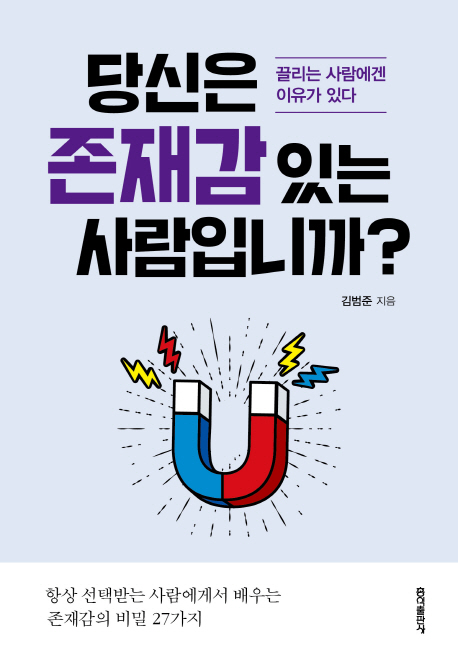
당신은 존재감 있는 사람입니까?
👍
동기부여가 필요할 때
추천!

가장 먼저 좋아요를 눌러보세요
2021년 1월 2일
 0
0
 0
0

정아름
@jungareumhynq
세상에 태어난 이유와 목적을 찾을 수 있을까?
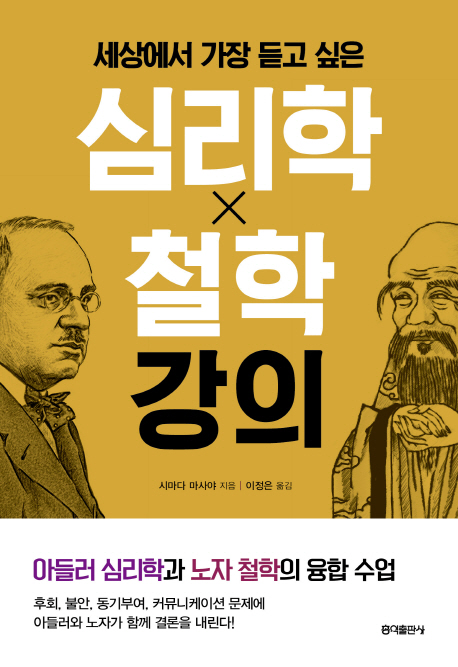
세상에서 가장 듣고 싶은 심리학 X 철학 강의
👍
불안할 때
추천!

1명이 좋아해요
2020년 9월 8일
 1
1
 0
0

정아름
@jungareumhynq
나이를 점점 먹어가면서 제일 피했던 독서분야 1순위가 자기계발이었다.
이미 차곡차곡 쌓여 있던 가치관이 뒤늦게 자기계발서를 보고 흔들릴수 있다는 지나가는 말때문이었다.
이 책을 읽게 된 이유는 플라이북스에서 달 마다 보내주는 책 중 이번달의 책 한권이었기때문이다.
독서 편식이 심한 내가 퇴근 후 별 생각없이 이 책을 읽어나가기 시작했다. 그렇게 일주일이 안되어 글을 다 읽게 되었다.
결국 요약해보면, 몸과 마음이 힘든 상황에서 독서와 좋은 멘토를 만나 실패를 거듭하며 성공할 수 있었다는 이야기.
또한, 이 책의 요점은
책을 많이 읽어라.
티비와 스마트폰을 멀리해라.
멘토를 찾아라.
목표를 잡아라.
누구나 알고 있는 이야기이지만 참 실천하기 어려운 것들을 해야한다라고 말하는 이야기라고 할 수 있겠다.
이미 차곡차곡 쌓여 있던 가치관이 뒤늦게 자기계발서를 보고 흔들릴수 있다는 지나가는 말때문이었다.
이 책을 읽게 된 이유는 플라이북스에서 달 마다 보내주는 책 중 이번달의 책 한권이었기때문이다.
독서 편식이 심한 내가 퇴근 후 별 생각없이 이 책을 읽어나가기 시작했다. 그렇게 일주일이 안되어 글을 다 읽게 되었다.
결국 요약해보면, 몸과 마음이 힘든 상황에서 독서와 좋은 멘토를 만나 실패를 거듭하며 성공할 수 있었다는 이야기.
또한, 이 책의 요점은
책을 많이 읽어라.
티비와 스마트폰을 멀리해라.
멘토를 찾아라.
목표를 잡아라.
누구나 알고 있는 이야기이지만 참 실천하기 어려운 것들을 해야한다라고 말하는 이야기라고 할 수 있겠다.
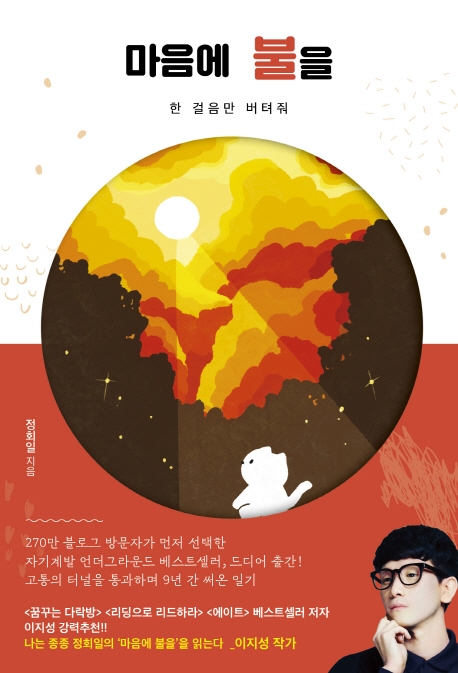
마음에 불을
👍
불안할 때
추천!



외 1명이 좋아해요
2020년 8월 8일
 4
4
 0
0
게시물 더보기
웹으로 보기

